The digital revolution has changed how products are designed. Today digital data from a 3D model, produced predominantly using a CAD system, is exported to CAM software, which is used to convert that model into a file format that can be sent to a fabrication tool that will then produce a physical replica of that digital model.
.
Fabrication tools are computer-controlled manufacturing processes and are either additive or subtractive. The additive process is 3D printing, which builds a product up by adding material layer-by-layer, whereas the subtractive process, which includes CNC machining and laser cutting, removes material from a solid block or sheet to create a product. This workflow of turning digital data into physical objects is referred to as digital modelling and fabrication. […]
Case Study: How PepsiCo achieved 96% cost savings on tooling with 3D Printing Technology
Above: PepsiCo food, snack, and beverage product line-up/Source: PepsiCo PepsiCo turned to tooling with 3D printing...




0 Comments